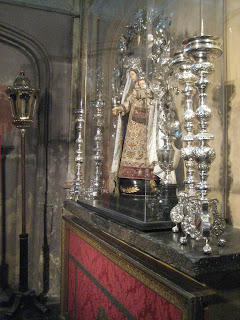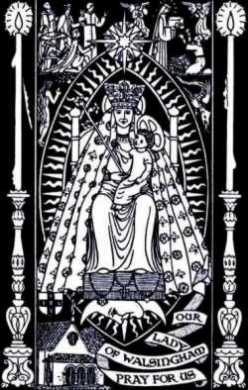 Saint Salvator's Church became the Cathedral when the French occupants of Bruges chased the Bishop away and demolished the Cathedral of Saint Donatius at the end of the Eighteenth century. Lacking the money for a new Cathedral and as the Church of Our Lady, which I will show in a later post, was unwilling to take on the status, this Church was, soon after Belgian independence in 1830, modified and became the Cathedral. Much of the work was carried out by noted English architect William Chantrell, known for his neo gothic restorations.
Saint Salvator's Church became the Cathedral when the French occupants of Bruges chased the Bishop away and demolished the Cathedral of Saint Donatius at the end of the Eighteenth century. Lacking the money for a new Cathedral and as the Church of Our Lady, which I will show in a later post, was unwilling to take on the status, this Church was, soon after Belgian independence in 1830, modified and became the Cathedral. Much of the work was carried out by noted English architect William Chantrell, known for his neo gothic restorations.Some pieces rescued from the previous Cathedral were incorporated into the new one, including this altar which takes up one of the twelve octagonal chapels which make up the rebuilt East wall. The reredos shows the genealogy of Our Lady, and very much repays expanding.
 Much of the arcading around the back of the High Altar reredos making up the ambulatory between the twelve Chapels is used to display exhibits from the collection of the Cathedral. The central chapel takes up two spaces and is used for daily Mass. The twenty seats set out reminded me of the twenty Masses per day said in the Basilica in Krakow, each one well attended.
Much of the arcading around the back of the High Altar reredos making up the ambulatory between the twelve Chapels is used to display exhibits from the collection of the Cathedral. The central chapel takes up two spaces and is used for daily Mass. The twenty seats set out reminded me of the twenty Masses per day said in the Basilica in Krakow, each one well attended. The Cathedra at the High Altar. The original chair has been removed with its baldachin to the Nave Altar, leaving this one used for the occasional Vespers attended by the Canons. The lanterns are of note, probably Spanish or Portuguese, these were once ubiquitous in Europe and South America in outdoor processions. The Anglican Shrine at Walsingham has a pair which are used from time to time, brought back, I imagine, by Father Hope Patten during one of his holidays.
The Cathedra at the High Altar. The original chair has been removed with its baldachin to the Nave Altar, leaving this one used for the occasional Vespers attended by the Canons. The lanterns are of note, probably Spanish or Portuguese, these were once ubiquitous in Europe and South America in outdoor processions. The Anglican Shrine at Walsingham has a pair which are used from time to time, brought back, I imagine, by Father Hope Patten during one of his holidays. Another shrine, dedicated to Our Lady. The candlesticks are very fine, Belgium was once a centre for excellent silver and goldsmiths, Henri Flamelle being perhaps one of the more famous.
Another shrine, dedicated to Our Lady. The candlesticks are very fine, Belgium was once a centre for excellent silver and goldsmiths, Henri Flamelle being perhaps one of the more famous. The Sepulchre Chapel greatly appealed to me. It stands at the end of the North Arcade and the rays around the crucifix shine brightly as the sun hits from the clerestory windows.
The Sepulchre Chapel greatly appealed to me. It stands at the end of the North Arcade and the rays around the crucifix shine brightly as the sun hits from the clerestory windows. This arcading underneath the great Organ Loft at the West end of the Cathedral is very fine. The (I assume terracotta) work on the ceiling and the marble work could come straight from the Opera House in Paris and indeed has a distinctly secular note.
This arcading underneath the great Organ Loft at the West end of the Cathedral is very fine. The (I assume terracotta) work on the ceiling and the marble work could come straight from the Opera House in Paris and indeed has a distinctly secular note. This long view down the nave shows the new position of the Cathedra and also shows the tapestries rescued from the old Cathedral in the Sanctuary. They date from the thirteenth century and are quite faded, to my eyes, they did not beautify the space at all.
This long view down the nave shows the new position of the Cathedra and also shows the tapestries rescued from the old Cathedral in the Sanctuary. They date from the thirteenth century and are quite faded, to my eyes, they did not beautify the space at all. Here is the back of the monumental pulpit. The stairs are steep and must have posed a problem to the averagely dressed Renaissance cleric, but are nothing like as steep as the stair in Our Lady's Church around the corner, which must have taken some nerve to descend in clerical dress. Continuing our Opera House theme, the curtains at the top are not unlike those leading to a box at the opera, the Corinthian granite columns only adding to the sense of theatre.
Here is the back of the monumental pulpit. The stairs are steep and must have posed a problem to the averagely dressed Renaissance cleric, but are nothing like as steep as the stair in Our Lady's Church around the corner, which must have taken some nerve to descend in clerical dress. Continuing our Opera House theme, the curtains at the top are not unlike those leading to a box at the opera, the Corinthian granite columns only adding to the sense of theatre. The light shines onto the grand organ loft. Can I ask Wanderers to notice that Father Francis Wadsworth's blog has undergone a transformation? The old one is gone and the new one, listed on the sidebar, is 'Saint Marie's Bury'. Thank you, back to your Brown Windsor soup.
The light shines onto the grand organ loft. Can I ask Wanderers to notice that Father Francis Wadsworth's blog has undergone a transformation? The old one is gone and the new one, listed on the sidebar, is 'Saint Marie's Bury'. Thank you, back to your Brown Windsor soup.

_Black_s_s_s_s_s.jpg)
